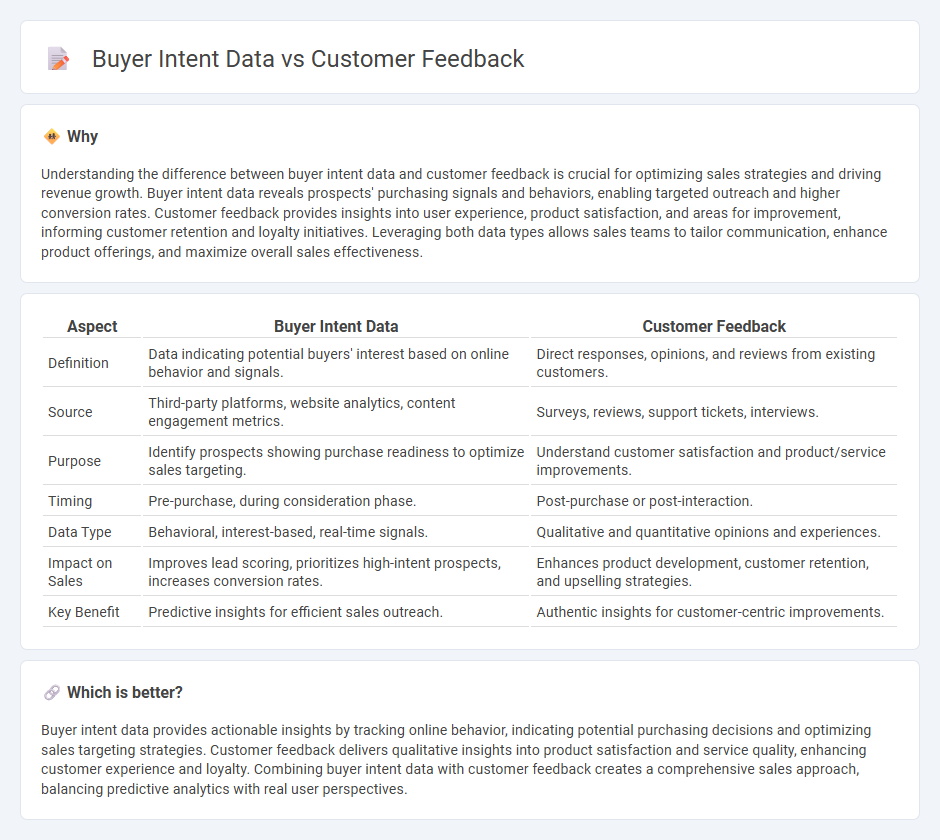
Buyer intent data captures real-time signals indicating a prospect's readiness to purchase, such as browsing behavior and content consumption patterns. Customer feedback provides direct insights from buyers about their experiences, preferences, and satisfaction levels post-purchase. Discover how integrating buyer intent data and customer feedback can enhance your sales strategy.
Why it is important
Understanding the difference between buyer intent data and customer feedback is crucial for optimizing sales strategies and driving revenue growth. Buyer intent data reveals prospects' purchasing signals and behaviors, enabling targeted outreach and higher conversion rates. Customer feedback provides insights into user experience, product satisfaction, and areas for improvement, informing customer retention and loyalty initiatives. Leveraging both data types allows sales teams to tailor communication, enhance product offerings, and maximize overall sales effectiveness.
Comparison Table
| Aspect | Buyer Intent Data | Customer Feedback |
|---|---|---|
| Definition | Data indicating potential buyers' interest based on online behavior and signals. | Direct responses, opinions, and reviews from existing customers. |
| Source | Third-party platforms, website analytics, content engagement metrics. | Surveys, reviews, support tickets, interviews. |
| Purpose | Identify prospects showing purchase readiness to optimize sales targeting. | Understand customer satisfaction and product/service improvements. |
| Timing | Pre-purchase, during consideration phase. | Post-purchase or post-interaction. |
| Data Type | Behavioral, interest-based, real-time signals. | Qualitative and quantitative opinions and experiences. |
| Impact on Sales | Improves lead scoring, prioritizes high-intent prospects, increases conversion rates. | Enhances product development, customer retention, and upselling strategies. |
| Key Benefit | Predictive insights for efficient sales outreach. | Authentic insights for customer-centric improvements. |
Which is better?
Buyer intent data provides actionable insights by tracking online behavior, indicating potential purchasing decisions and optimizing sales targeting strategies. Customer feedback delivers qualitative insights into product satisfaction and service quality, enhancing customer experience and loyalty. Combining buyer intent data with customer feedback creates a comprehensive sales approach, balancing predictive analytics with real user perspectives.
Connection
Buyer intent data captures signals such as browsing behavior, content engagement, and search queries that indicate a prospect's readiness to purchase. Customer feedback provides qualitative insights into customer experiences and satisfaction, helping to contextualize and validate buyer intent signals. Integrating both Buyer intent data and customer feedback enables sales teams to tailor their strategies more effectively, improving lead qualification and conversion rates.
Key Terms
Customer Feedback:
Customer feedback provides direct insights from users about their experiences, preferences, and pain points, offering qualitative data essential for product improvement and customer satisfaction. This feedback is gathered through surveys, reviews, and support interactions, reflecting genuine user sentiment and guiding businesses in refining their offerings. Explore more to understand how customer feedback can transform your business strategies.
Net Promoter Score (NPS)
Customer feedback provides qualitative insights into satisfaction and experience, often captured through surveys measuring the Net Promoter Score (NPS), which quantifies loyalty by identifying promoters, passives, and detractors. Buyer intent data, meanwhile, focuses on real-time behavioral signals such as website visits, content engagement, and purchase patterns to predict the likelihood of a sale. Explore how integrating NPS with buyer intent data can enhance customer understanding and drive targeted marketing strategies.
Customer Satisfaction (CSAT)
Customer feedback provides direct insights into Customer Satisfaction (CSAT) by capturing explicit opinions, ratings, and qualitative comments about products or services. Buyer intent data reveals behavioral signals indicating the likelihood of a purchase, but it lacks the emotional and experiential context critical to measuring satisfaction. Explore how integrating both data types can enhance your understanding of customer satisfaction metrics and drive business growth.
Source and External Links
7 Reasons Why Customer Feedback Is Important To Your Business - Customer feedback helps businesses improve customer experience, enhance retention, and foster loyalty by addressing satisfaction and dissatisfaction directly through customer insights.
Customer Feedback Loops: Insights For Continuous Improvement - Effective customer feedback loops, like those used by Starbucks and Amazon, show how collecting and implementing feedback continuously can improve products and services while building customer trust.
7 Types of Customer Feedback Examples to Drive Growth in 2025 - Combining qualitative and quantitative feedback gathered from surveys, social media, and reviews allows businesses to analyze customer needs and improve their offerings comprehensively.
 dowidth.com
dowidth.com